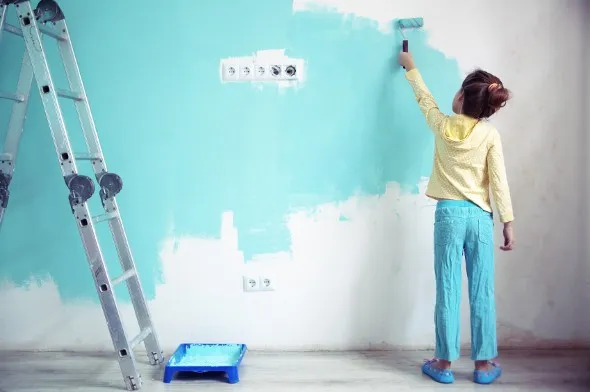If the house you bought doesn’t resemble the home of your dreams, don’t fret. With a decent budget and a little extra attention, you might be able to whip it into shape. Securing the funds for home improvement, however, is no easy task. Fortunately, the federal government offers a loan called the FHA 203(k) that can help make your renovations more affordable.
Find out now: How much house can I afford?
What You Should Know About the FHA 203(k) Loan Program
So what exactly is the point of a 203(k) loan? It’s an offer from the Federal Housing Administration (FHA) that gives homeowners the opportunity to include the costs of remodeling and construction with their new or existing mortgages.
To put it more simply, you receive a single loan that pays for both your house and any projects that need to be done. Even if you’re going through a refinance, taking on this loan could give you the financial backing you need to make your home look brand new.
The 203(k) loan isn’t intended to help reduce the costs of refurbishing every home in the country. It’s specifically geared toward existing single-family to four-family homes that have been in place for one year or more.
The loan can also go toward paying for certain condos, homes that will be transferred to different areas or any house that has been torn down if at least a portion of its foundation is still intact.
Check out our mortgage calculator.
How You Can Use a 203(k) Loan

The FHA identifies the kind of home construction projects that can be completed using one of two different types of 203(k) loans. If you want to have a new structure in your home such as a new bedroom or a basement, you would apply for a standard 203(k) loan. But if you need something else done that doesn’t require any building (like adding new furniture to your living room) you would need to look into getting a streamlined 203(k) loan.
Your 203(k) loan can cover just about any home repair you can think of, from plumbing to adding an additional floor to your home. Don’t get too excited, though, because there are some exceptions. If you wanted to add in a backyard swimming pool or anything considered to be a luxury, you’d have to find a way to pay for those things on your own.
You might also want to think about having some kind of budget in place to account for the loan’s limits. Streamlined 203(k) loans cannot exceed $35,000. With traditional 203(k) loans, you’ll get up to 110% of the amount that the home could be worth once it has been renovated, or the current value of your home combined with anticipated construction expenses. Your lender will choose the amount that’s the lowest of the two.
FHA 203(k) Loan Requirements
There are other guidelines put in place by the FHA and the Department of Housing and Urban Development (HUD) that you’ll have to follow if you want to qualify for a 203(k) loan.
Typically when you buy a home, it’s a good idea to aim for putting at least 20% as a down payment. With a 203(k) loan, you’re only responsible for putting down 3.5% of the home price ahead of time. However, you should prepare yourself to pay for mortgage insurance for at least 11 years.
Just about any homeowner can apply for a 203(k) loan, as long as your home isn’t worth more than a certain threshold that varies based on where you’re located. You can expect to go through an application process that’s similar to the one required for a regular mortgage loan. So it’s important to make sure your credit score looks as good as possible and that all of your financial documents are ready to submit to your lender.
But there’s more. You might have to get your home appraised before getting approved for the loan, unless your lender is willing to accept the sale price of your house instead of requiring a new appraisal. Plus, you can count on having to turn in some kind of blueprint with an estimate of how much all of your projects will cost. One item you should take care not to forget in your proposal is the fees you’ll pay your contractor for finishing the job.
If you’re approved for either kind of 203(k) mortgage loan, you won’t have years to get your renovations done. Generally, you’ll only have six months to work with. Once you’ve gone through closing, construction must begin within a 30-day window.
Related Article: What Are HUD Loans?
FHA 203(k) Loan Rates and Lenders

If all of these requirements make you nervous, don’t worry. Finding a lender for your 203(k) rehab loan won’t be so complicated. HUD lets you search through a list of lenders based on where you live. Best of all, you’ll find the most experienced lenders included on the website who have all worked on a 203(k) loan at some point within a year.
Once you’ve done some research and you’ve chosen a lender, your loan rates will likely look a little higher than those for other FHA loans. Only 30-year fixed term mortgages are available through this FHA program, which could potentially be a downside for some people.
The Takeaway
FHA 203(k) loans can be helpful because they allow communities that have fallen on hard times to be strengthened and rebuilt. Homeowners who wouldn’t otherwise have enough money to pay for repairs by themselves essentially get a helping hand from Uncle Sam. And if you’re approved for the loan, you’ll only have to remember to make one monthly payment for your mortgage and your renovation loan.
Unfortunately, not every type of home can be remodeled using money from a 203(k) loan. The process of getting this type of loan can be a long one, especially with all of the paperwork and details you’ll have to work out. Finding a lender who has worked with these types of loans before can be a good way to make the application process less bumpy.
Photo credit: ©iStock.com/cjp, ©iStock.com/alenkasm, ©iStock.com/laflor
